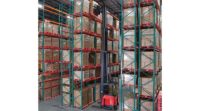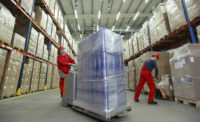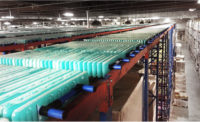When it comes to energy management and productivity, doors are sometimes overlooked as an opportunity for improvement of cold storage operations. High-speed doors can help prevent the infiltration of warm air to food storage areas and keep material-handling equipment operating productively and safely.
Each door represents a hole in the building envelope that provides an escape route for energy every time traffic enters and exits the building, or travels from a refrigerated section to one that is at room temperature. As a result, smart building owners and managers focus on sealing up every crack in the building envelope.
In a typical cold storage facility, doors open and close hundreds of times per day. In facilities that operate 24/7, they may cycle more than a thousand times a day, as forklifts move food in and out of cold storage areas, docks, laboratories and packaging areas.
Doorways, therefore, have a big impact on the energy budgets of cold storage facilities. Depending on the food processes being performed within the building, temperature differentials between rooms can be considerable. Positive and negative pressures tend to push out conditioned air and pull in warm air every time a door opens.
Cold storage facility owners have long recognized the critical role that doors play in the battle against this type of energy loss. To combat it, their traditional solution has been to install heavy panel sliding doors inside the building and sectional garage-style doors on exterior walls. Both styles of doors typically are heavily insulated for high R-value but tend to be slow-moving. That means they can impede time-sensitive traffic.
Doors in cold storage facilities also must be extremely reliable for the facility to meet its tight shipment schedules and customer demands. Even the loss of one door can cause a massive hit on productivity, as material-handling vehicles must use other routes through the building or are diverted to use other loading areas.
Maintaining a constant temperature in production and storage areas is important in preventing food spoilage. But it also has implications for employee comfort and safety. Employees working near cold storage areas may need to dress warmer to deal with cold air from exposed openings. This can have a negative impact on their productivity and their level of satisfaction with their work. Frost and ice buildups around doorways that lead in and out of cold storage areas is yet another issue, one which can create potential safety hazards.
The latest trend in the construction of new cold storage facilities is to build them taller, on a smaller total footprint. High-masted forklifts are used to place and retrieve products from tall, multi-tiered shelves. This has driven the need for tall bi-parting doors to accommodate these mega-material handlers. But with taller door openings comes the potential for greater energy loss. Also, a smaller building footprint usually means more traffic must be funneled through fewer door openings, making door reliability even more critical.
How High-Speed Doors Can Help
One potential solution to these challenges is to specify high-speed doors for all your critical cold storage areas. They offer several key advantages to building owners:
Significant energy savings: At a major food production and distribution facility in suburban Chicago, high-speed doors have reduced energy consumption by 40%. They also minimized operating time on the refrigeration system for a longer life, since it doesn’t need to work as hard to compensate for energy losses. Because high-speed doors can have an opening speed of up to 100 inches per second, air infiltration into refrigerated and frozen food processing and storage areas is kept to a minimum.
Many of today’s high-speed doors are specifically designed for cold-storage environments, composed of materials that have a high R-value. Plus, they have specially-designed seals on the sides and bottom to form an energy-efficient seal when the door is closed.
Fewer opportunities for collisions between doors and material-handling vehicles: Material-handling vehicles rarely catch up with high-speed doors. If they do collide, some models have a quick reset feature to put the door back in service quickly, eliminating or minimizing downtime.
When a slow, solid panel door is hit, it can be misaligned or, even worse, the door can be taken out of action and the doorway can be left exposed. While disabled, energy loss will be considerable. However, since a vehicle is unlikely to make contact with a rapidly-moving, high-speed door, the doorway is nearly always protected against energy loss.
Safety features: Modern high-speed doors offer multiple safety features that keep forklift operators and other personnel safe around them, including:
- Safety devices (sensors, reversing bottom edge and breakaway functionality);
- Signaling devices (visible lights when a door is closing or is about to close, timer/countdown, horn or audible warning); and
- Activation devices (motion sensors, pull cords).
Low maintenance: Unlike heavily insulated doors, the lightweight panels and roll-up or sliding designs put less strain on operating parts and require lower horsepower drives to operate. As a result, downtime and maintenance costs on them tend to be minimal. Also, remote controls enable maintenance people to adjust door performance from floor level, eliminating the need to access the door’s drive motor and controls with an aerial lift.




